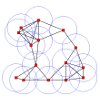Discrete Geometry and Combinatorics Seminar
What are all the ways to arrange $N$ hard spheres to form a rigid cluster? And what can the solution tell us about how materials crystallize? I will explain an algorithm to tackle the first question, and show that it produces many clusters with geometrically unusual properties. Most notably perhaps is the preponderance of "singular" clusters, those that are linearly flexible but nonlinearly rigid, so-called because they correspond to singular solutions to a set of algebraic equations. These are also the clusters one sees with unusually high probability in experiments (which consider colloidal particles interacting with a short-range potential), but evaluating this probability is impossible using standard tools from statistical mechanics. I will show that by taking a geometrical approach, we can approximate this probability for all clusters that are "second-order rigid". This calculation suggests that the free-energy landscape of a finite collection of hard spheres has a universal shape, and it brings insight into the pathways to crystallization; these observations are empirical and could benefit from a geometric analysis.
